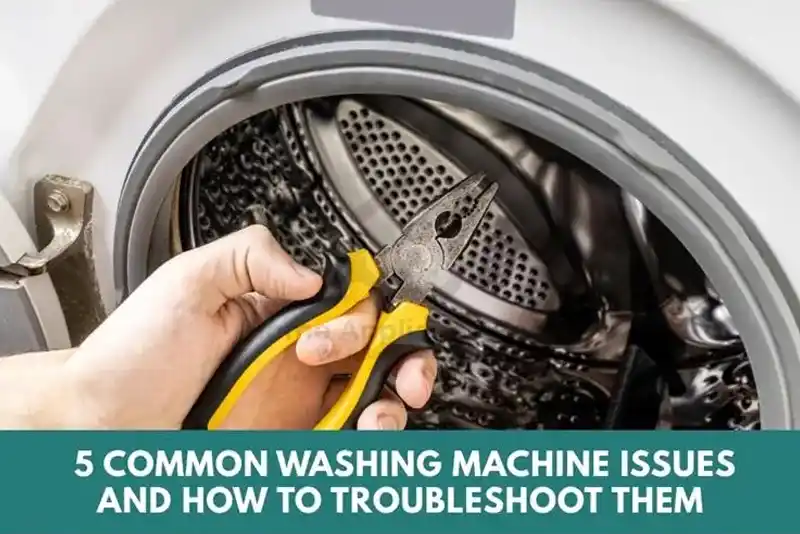Table of Contents
ToggleIntroduction: Having Washing Machine Problems? You’re Not Alone.
A washing device is an important modern-day thing that keeps our clothes fresh and smooth. But what takes place when your washing machine starts performing? Whether it is leaking water, no longer draining, or refusing to start, it can be pretty irritating—not to say disruptive to your everyday routine.
Before you rush to call an equipment restore provider, take a second to respire. Many unusual washing machine problems can be diagnosed and fixed at home with persistence and proper understanding.
In this professional guide, we’ll break down five common washing machine problems and show you a way to troubleshoot them step-by-step. These sensible guidelines will save you time, cash, and stress.
1. Washer Not Spinning
Symptoms:
Clothes come soaking moist, or the spin cycle never kicks in.
Why it Happens:
- Unbalanced or overloaded drum
- Malfunctioning lid switch or door latch
- Worn-out force belt or motor coupling
- Clogged or faulty drain pump
Troubleshooting Steps:
- Balance the Load: Overloading or choppy distribution of clothes is one of the top causes of spin failure. Spread the clothes lightly.
- Check the Lid Switch (Top-Load): A faulty lid switch prevents the washer from spinning. You’ll want to check the switch with the use of a multimeter.
- Inspect the Belt: Remove the rear panel and have a look at the pressure belt to wear or damage.
- Clean the Pump Filter: A clogged drain pump can prevent it from spinning. Clear out any debris from the filter.
Pro tip for washing machine problems: If your top-load washing machine won’t spin, the issue is usually a damaged lid switch, an easy component to replace.
2. Washing Machine Leaking Water
Symptoms:
Water pooling under or around the washing machine.
Common Causes:
- Cracked water inlet hoses
- Damaged door boot seal (in the front-load washers)
- Loose hose connections
- Using an excessive amount of detergent
DIY Fixes:
- Inspect All Hoses: Unplug the washing machine and check the inlet and drain hoses. Replace any that is cracked or bulging.
- Tighten Connections: Secure hose clamps with a screwdriver.
- Clean the Door Gasket: Mold, lint, or small items can create tiny gaps within the door seal.
- Use the Right Detergent: High-efficiency washers require low-sud detergent. Excess suds can lead to overflows.
Call a Pro: If the leak continues after simple fixes, it might be an inner problem that calls for a certified technician.
3. Washer Won’t Drain
Symptoms:
Water stays inside the drum, or the cycle doesn’t end.
Possible Causes:
- Blocked or kinked drain hose
- Clogged drain pump filters out
- Faulty pump motor
- Obstructions within the hose (socks, cash, and so forth.)
How to Fix It:
- Check the Hose: Make sure it’s not twisted or blocked.
- Clean the Filter: Look for a small access panel close to the bottom of the front of your washing machine. Unscrew and ease the pump filters out.
- Inspect the Drain Pump: If cleaning doesn’t fix it, test the pump’s functionality.
Helpful tip for washing machine problems: Regularly clean the filter every few months to avoid buildup.
4. Strange Noises During Washing or Spinning
Symptoms:
Thudding, squeaking, grinding, or damn sounds.
Likely Reasons:
- Loose drum bearings
- Objects caught inside the drum (like coins, hairpins)
- Shock absorbers or suspension springs failing
- Broken motor coupling
DIY Troubleshooting:
- Check the Drum: Spin it by using your hand to see if it wobbles or grinds.
- Look for Foreign Objects: Remove any small objects caught between the drum and tub.
- Open the Back Panel: Examine suspension rods or shock absorbers.
Quick Fix: Avoid overloading the washing machine—this places strain on internal elements.

5. Washing Machine Won’t Start
Symptoms:
No strength, no lighting fixtures, and nothing occurs whilst pressing the start button.
Possible Issues:
- Power cord unplugged or outlet not operating
- Tripped circuit breaker
- Faulty door latch or lock
- Failed control board
What to Do:
- Check the Outlet: Plug in some other device to verify electricity.
- Reset the Breaker: Sometimes a surge can trip your electric panel.
- Inspect Door Lock: Most washers won’t start unless the door is securely latched.
- Test the Start Switch and Control Board: If you’re tech-savvy, you may take a look at the continuity of the usage of a multimeter.
When to Call Help: If the control board is damaged, you’ll need a technician to securely fix it.
Bonus Tips for Preventing Washing Machine Problems
- Clean the drum and filter monthly.
- Leave the door open after each wash to prevent mold.
- Avoid overloading the washer.
- Use the best HE detergent in an excessive-efficiency fashion.
- Inspect hoses every 6 months to prevent unexpected leaks.
By following those preventive maintenance steps, you could extend your washer’s life and avoid common headaches.
Still Can’t Fix It? Call Home Appliance Care for Fast, Local Repair
If those washer troubleshooting guidelines didn’t clear up the problem, don’t worry. At Home Appliance Care, we specialize in short, low-priced, and expert washing machine repair offerings throughout Virginia and Maryland, such as:
- Alexandria
- Arlington
- McLean
- Fort Washington
- Falls Church
- Silver Spring, and more.
We work with all predominant brands like Whirlpool, Samsung, LG, GE, Maytag, Bosch, and Kenmore.
- Fully educated technicians
- Same-day carrier in most areas
- Transparent pricing
Call Now: (571) 200-1953
Book Online: https://homeappliancecare.us/schedule-service/
Emails: support@homeappliancecare.us

